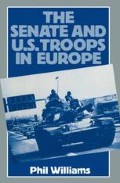Abstract
Although the American military presence has become a central feature of security arrangements in Europe, the United States in the late 1940s had no intention of making such a deployment. As late as 1948 an ‘entangling alliance’ with Western Europe was still regarded as ‘worse than original sin’.1 The Truman Administration had committed itself to the economic recovery of Western Europe through Marshall Aid, but this was intended to restore an indigenous balance of power in Erope and thereby ensure that the United States did not become more directly involved.2 Not only was the aid programme based on the principle of European self-help, it also anticipated that it would promote European self-reliance. The consequences for the United States, however, were very different from its intentions, and what had been regarded as the final stage in America’s European policy became merely an interim measure, as it became clear that the economic recovery programme was unlikely to come to fruition without steps to reassure Western Europe that its security would also be underwritten.
Access this chapter
Tax calculation will be finalised at checkout
Purchases are for personal use only
Preview
Unable to display preview. Download preview PDF.
Notes and References
Quoted in L. S. Kaplan, A Community of Interests: NATO and the Military Assistance Program, 1948–1951 (Washington: Office of the Secretary of Defense, Historical Office, 1980) p. 17.
This is one of the main themes of T. Ireland, Creating the Entangling Alliance: The Origins of the North Atlantic Treaty Organisation (London: Aldwych Press, 1981).
See S. M. Hartmann, Truman and the Eightieth Congress (Columbia: University of Missouri Press, 1971) and
W. C. Cromwell. Hartmann, Truman and the Eightieth Congress (Columbia: University of Missouri Press, 1971) and
W. C. Cromwell, ‘The Marshall Non Plan, Congress and the Soviet Union’, Western Political Quarterly, vol. 32 (1979) 422–43.
A good account can be found in J. Eayrs, In Defence of Canada: Growing Up Allied (University of Toronto Press, 1980) pp. 89–96.
See E. Reid, Time of Fear and Hope: The Making of the North Atlantic Treaty (Toronto: McCleland and Stewart, 1977) p. 143.
The text is contained in T. H. Etzold and J. L. Gaddis, Containment: Documents on American Policy and Strategy 1945–50 (New York: Columbia University Press, 1978) pp. 144–53.
On the decline of bipartisanship, see H. B. Westerfield, Foreign Policy and Party Politics (New Haven: Yale University Press, 1955) pp. 326–30.
The rivalry is discussed in D. Acheson, Sketches From Life of Men I have Known (New York: Harper amp; Row, 1961) pp. 123–32.
For an account of the meeting see D. Acheson, Present at the Creation (London: Hamilton, 1970) p. 281.
D. S. McLellan, Dean Acheson: The State Department Years (New York: Dodd, Mead, 1976) p. 151.
T. Connally, My Name is Tom Connally (New York: Crowell, 1954) pp. 332–3.
D. N. Farnsworth, The Senate Committee on Foreign Relations (Urbana: University of Illinois Press, 1961) p. 71.
J. Reston, ‘Isolationism is not Main Factor in Pact Debate’, New York Times, 20 Feb 1949. Section 4, p. 3.
J. J. McCloy, The Atlantic Alliance: Its Origin and Future (New York: Columbia University Press, 1969) p. 25.
A. H. Vandenberg Jr (ed), The Private Papers of Senator Vandenberg (Boston: Houghton Mifflin, 1952) p. 493.
J. L. Bryniarski, ‘Against the Tide: Senate Opposition to the Internationalist Foreign Policy of Presidents Roosevelt and Truman’ (University of Maryland, PhD diss, 1972) pp. 279–80.
C. V. Crabb, Bipartisan Foreign Policy: Myth or Reality (New York: Harper amp; Row, 1957) p. 86.
M. Bundy (ed), The Pattern of Responsibility (Boston: Houghton Mifflin, 1952) p. 76.
T. Lowi, ‘Making Democracy Safe for the World’ in J. Rosenau (ed), The Domestic Sources of Foreign Policy (New York: Free Press, 1967) p. 315.
Copyright information
© 1985 Phil Williams
About this chapter
Cite this chapter
Williams, P. (1985). The North Atlantic Treaty, Military Assistance and the Troops to Europe Decision. In: The Senate and US Troops in Europe. Palgrave Macmillan, London. https://doi.org/10.1007/978-1-349-06430-4_2
Download citation
DOI: https://doi.org/10.1007/978-1-349-06430-4_2
Publisher Name: Palgrave Macmillan, London
Print ISBN: 978-1-349-06432-8
Online ISBN: 978-1-349-06430-4
eBook Packages: Palgrave Political & Intern. Studies CollectionPolitical Science and International Studies (R0)

